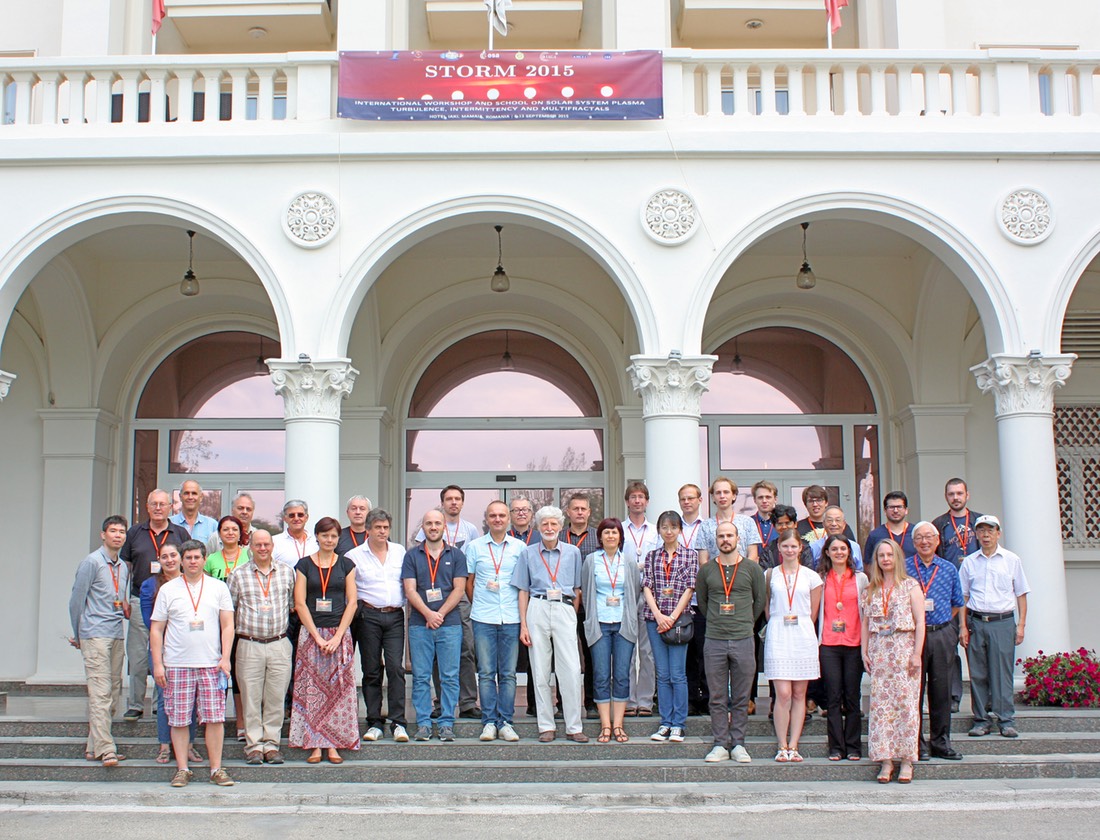
STORM 2015 Group Photo (click HERE to download high-resolution photo)
The “International Workshop and School on solar system plasma turbulence, intermittency and multifractals (STORM 2015)” focus on the quantitative experimental, theoretical and numerical investigation of turbulence, intermittency, fractal/multifractal features, waves and coherent structures interaction, criticality and non-linear cross-scale coupling. As widely documented by in-situ satellite measurements and remote or ground-based observations, turbulence, intermittency and dynamical complexity are quite ubiquitous processes observed in the dynamics of solar, planetary and interplanetary plasmas, as well as in the dynamical evolution of proxies linked to magnetospheric and ionospheric variability. Observational, numerical and theoretical studies of solar system plasmas raised fundamental scientific questions like:
- How is the turbulent energy transferred between scales?
- What is the role of coherent structures and boundaries for the structure of turbulence?
- Which are the mechanisms ensuring the energy dissipation?
- Which are the sources of intermittency and their role for turbulence structure?
- What is the role of turbulence for the coupling between the solar wind and the planetary plasma environments?
Unfolding the spatio-temporal structure of magnetic field and plasma fluctuations from experimental observations and numerical simulations provides further insight on the structure of plasma turbulence and intermittency. On the theoretical side, the understanding of such complex dynamical behavior cannot be simply surmised from the basic fluid/kinetic equations, but instead requires novel theoretical, experimental and data analysis approaches. The workshop is a forum to present and discuss latest results in these fields. The purpose of the school is to give to a young audience of Graduate, Ph.D. students, and postdoc scientists, which ideally represents the next generation of scholars in the physics of space plasmas, an overall view of both theoretical and data analysis tools apt to fully exploit unique and unprecedented observations that will be provided by future upcoming mission like Solar Orbiter and Solar Probe Plus.
Scientific Organizing Committee (SOC):
- Roberto Bruno, National Institute for Astrophysics, Italy
- Tom Chang, MIT Kavli Institute for Astrophysics and Space Research, USA
- Giuseppe Consolini, National Institute for Astrophysics, Italy
- Marius Echim, Belgian Institute for Space Aeronomy, Belgium
- Karl-Heinz Glassmeier, Technical University Braunschweig, Germany
- Jay Johnson, Princeton Plasma Physics Laboratory, USA
- Peter Kovacs, Geological and Geophysical Institute of Hungary, Hungary
- Hervé Lamy, Belgian Institute for Space Aeronomy, Belgium
- Wieslaw Macek, Space Research Center, Poland
- Kalevi Mursula, University of Oulu, Finland
- Yasuhito Narita, Space Institute Graz, Austria
- Eliza Teodorescu, Institute of Space Science, Romania
- Zoltan Voeroes, Space Institute Graz, Austria
- Gabriel Voitcu, Institute of Space Science, Romania
- Emiliya Yordanova, Swedish Institute for Space Physics, Sweden
Local Organizing Committee (LOC):
- Marius Echim, Belgian Institute for Space Aeronomy, Belgium
- Eliza Teodorescu, Institute of Space Science, Romania
- Gabriel Voitcu, Institute of Space Science, Romania
- Anna Wawrzaszek, Space Research Center, Poland
- Costel Munteanu, Institute of Space Science, Romania
- Liliana Nedelcu, Institute of Space Science, Romania
Sponsoring Institutions:
- European Community’s 7th Framework Programme through FP7 Project STORM
- United States Office of Naval Research Global (ONRG)
- European Geosciences Union (EGU)
- European Space Agency (ESA)
- International Association of Geomagnetism and Aeronomy (IAGA)
- Romanian National Authority for Scientific Research and Innovation (ANCSI)